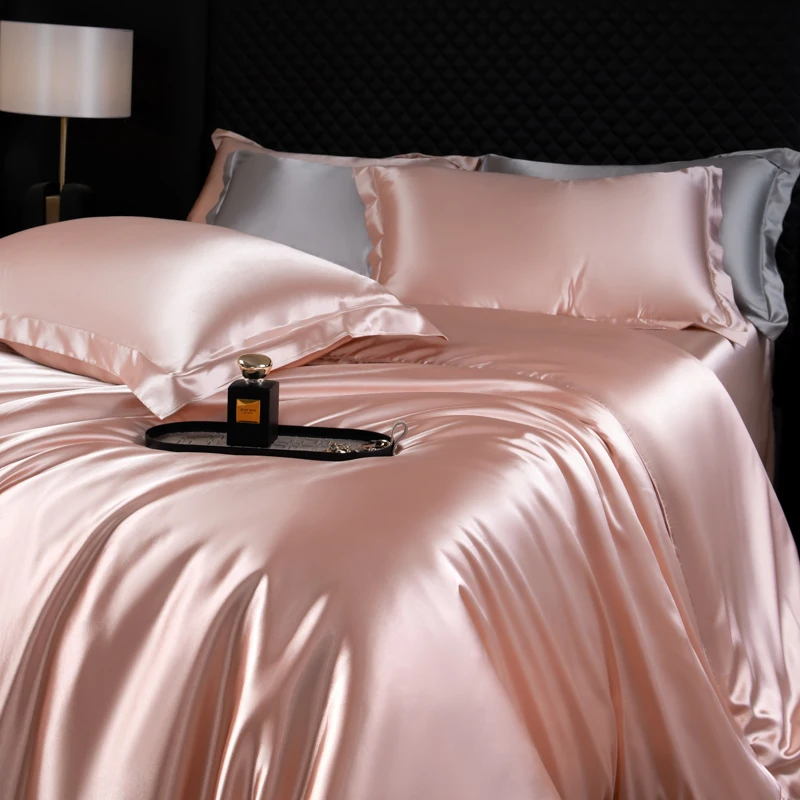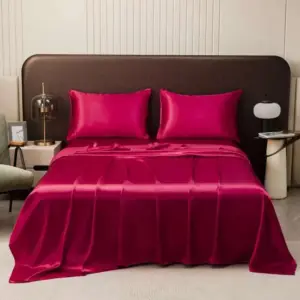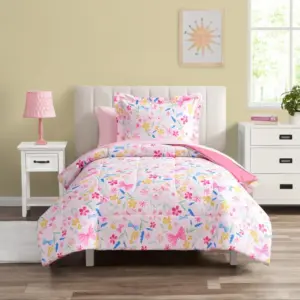Understanding Fabric Quality Measurements
When shopping for bedding and textiles, you’ll likely encounter various terms describing fabric quality. Two of the most important measurements—though often confused—are thread count and momme weight. Many people incorrectly search for “silk count” when looking for information about silk fabric quality, but this isn’t the correct terminology.
Thread count applies to woven fabrics like cotton, bamboo, and linen, while momme weight (pronounced “moh-mee”) is the proper measurement system specifically for silk fabrics. These distinct systems measure different aspects of fabric quality and apply to different materials.
Understanding the difference between these measurements helps you make smarter purchasing decisions when shopping for luxury bedding. Premium silk products, for instance, typically fall within the 19-25 momme weight range, offering an ideal balance of durability and luxurious feel.
As we explore these measurements in detail, you’ll gain clarity on how to evaluate fabric quality beyond marketing claims and discover why these metrics matter for your comfort and satisfaction.
The amazing benefits of Mulberry silk sheets become more apparent when you understand how momme weight contributes to silk’s unique properties.
What is Thread Count?
Thread count refers to the number of threads woven into one square inch of fabric, counting both horizontal (weft) and vertical (warp) threads. This measurement has traditionally been used as a quality indicator for woven fabrics, particularly for bed sheets and other textiles.
To determine thread count, manufacturers literally count the number of threads that fit within a 1”×1” square of fabric. For example, if there are 150 vertical threads and 150 horizontal threads in that square inch, the fabric has a thread count of 300.
The concept of thread count gained popularity in the 1990s as a marketing tool for bedding, particularly for cotton sheets. Before this period, consumers rarely heard about thread count. Today, it remains one of the most commonly referenced quality indicators for many fabric types.
How thread count is actually measured:
- Manufacturers count both warp (vertical) threads and weft (horizontal) threads in a square inch
- The two numbers are added together to create the thread count
- In quality fabrics, these threads are typically single-ply (consisting of one strand)
- Some manufacturers count multi-ply threads as multiple threads, which can inflate the number
The complete guide to Mulberry silk bed sheets explains why silk requires a different measurement system altogether.
Which Fabrics Use Thread Count?
Thread count is the appropriate quality measurement for many common fabric types, including:
- Cotton: Including Egyptian, Pima, Supima, and standard varieties
- Linen: Though linen typically has a lower thread count due to thicker fibers
- Bamboo: Often measured like cotton, though the fibers are processed differently
- Polyester and synthetic blends: Usually following cotton measurement conventions
- Microfiber: Often using thread count, though sometimes using GSM (grams per square meter)
- Cotton-silk blends: Using thread count but sometimes referencing momme for the silk content
Thread count works well for these fabrics because their fibers have sufficient thickness to be counted effectively within a square inch area. The structure of these fabrics allows for a meaningful correlation between thread density and quality—at least to a certain point.
Understanding the fundamental differences between cotton vs. silk quality metrics helps explain why each requires its own measurement system.
What Makes a “Good” Thread Count?
Contrary to popular belief, higher thread count doesn’t always mean better quality. Each fabric type has an optimal range that balances durability and comfort:
| Fabric Type | Ideal Thread Count Range | Notes |
|---|---|---|
| Cotton | 200-600 | Egyptian and Pima often at the higher end |
| Linen | 80-150 | Naturally thicker fibers result in lower counts |
| Bamboo | 250-500 | Similar to cotton but often feels softer |
| Polyester/Blends | 180-300 | Higher counts don’t significantly improve quality |
Thread count can be misleading, particularly when manufacturers use multi-ply threads (where several thin threads are twisted together) but count each thin thread separately. This practice artificially inflates numbers, sometimes advertising thread counts of 800, 1000, or even higher.
For most cotton sheets, thread counts between 300-500 offer the best balance of softness, durability, and breathability. Beyond 500, you’re often paying for marketing rather than quality. The quality of the fiber itself (like long-staple cotton) and the weave type usually have a greater impact on comfort than extremely high thread counts.
Our collection of premium silk sheets offers a different luxury experience that can’t be measured by thread count.
What is Momme Weight?
Momme weight (pronounced “moh-mee”) is the standard measurement system for silk fabric quality. Derived from ancient Japanese textile traditions, this unit measures the weight in pounds of a piece of silk fabric measuring 45 inches wide by 100 yards long.
In practical terms, momme weight indicates the density and quality of silk fabric. The higher the momme weight, the more silk has been used per square yard, resulting in a denser, more durable, and often more luxurious fabric.
A simple way to understand momme weight is to think of it as measuring silk’s “heaviness” or substantiality. Unlike thread count, which counts individual threads, momme provides insight into the overall density and quality of the silk fabric. This measurement is directly related to:
- The thickness of the silk
- The opacity of the fabric (how transparent it is)
- The durability and longevity of the silk product
- The richness of feel and drape
Momme weight is abbreviated as “mm” and is typically expressed as a number ranging from 6 to 30 for most consumer silk products.
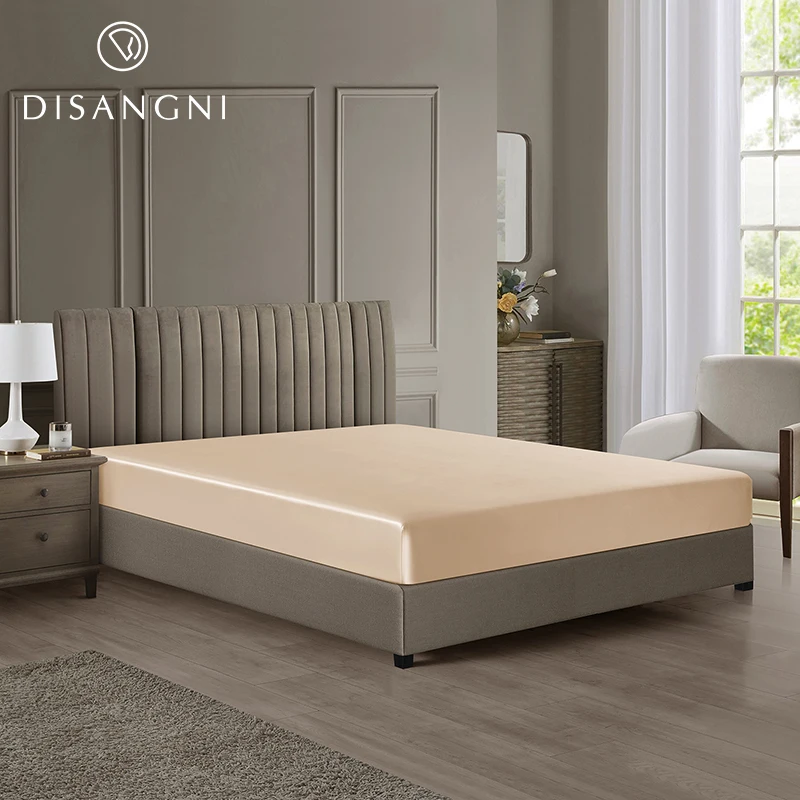
Our Mulberry silk sheets collection features carefully selected momme weights to ensure optimal luxury and durability.
Why Silk Uses Momme Weight Instead of Thread Count
Silk uses momme weight instead of thread count for several compelling reasons related to the unique nature of silk fibers:
Silk fibers are incredibly fine—approximately 1/5 the diameter of a human hair. This extreme fineness makes counting individual threads impractical and less meaningful. A single square inch of high-quality silk might contain thousands of filaments, making accurate counting virtually impossible.
Additionally, silk’s unique properties aren’t captured well by thread count. The strength, durability, and luxurious feel of silk come from the protein composition of the fibers themselves, not just how densely they’re woven. Weight provides a better indicator of these qualities.
The silk industry globally has standardized on momme weight because it provides a more accurate reflection of what consumers actually experience with the fabric: its substantiality, drape, and durability. When you handle two pieces of silk with different momme weights, the difference is immediately apparent through touch and sight.
Furthermore, momme weight directly correlates to the amount of raw silk material used, making it a more transparent measure of value. A higher momme weight generally means more silk has been used to create the fabric.
Understanding weight conversion for silk momme can help you make better comparisons between different silk products.
Momme Weight Quality Ranges for Different Silk Products
Different silk products require different momme weights to achieve optimal performance and longevity:
| Product Type | Recommended Momme Range | Characteristics |
|---|---|---|
| Lightweight garments | 6-8 mm | Sheer, lightweight, floaty feel |
| Scarves, blouses | 8-12 mm | Balance of drape and durability |
| Dresses, linings | 12-16 mm | Substantial feel with good movement |
| Bedding, pillowcases | 19-25 mm | Durability with luxury feel |
| Home decor, drapery | 16-22 mm | Substantial with elegant drape |
| Heavy furnishings | 22-30 mm | Maximum durability and opacity |
For bedding applications, 19-25 momme silk offers the ideal balance between luxury and practicality. At this weight range, silk sheets and pillowcases provide:
- Sufficient durability to withstand regular use and washing
- A substantial feel that conveys quality
- Excellent temperature regulation properties
- Appropriate opacity (not too transparent)
- The characteristic lustrous appearance silk is known for
Lower momme weights (under 19) in bedding may feel too delicate and wear out quickly, while higher weights (above 25) may lose some of silk’s characteristic drape and breathability.
Explore our premium silk pillowcases collection featuring optimal momme weights for both comfort and longevity.
Direct Comparison: Momme Weight vs. Thread Count
To understand how these two measurement systems differ, let’s compare them directly:
| Feature | Thread Count | Momme Weight |
|---|---|---|
| Definition | Number of threads per square inch | Weight in pounds of silk (45” × 100 yards) |
| Applicable fabrics | Cotton, linen, bamboo, synthetics | Exclusively silk |
| What it measures | Density of threads | Weight/density of fabric |
| Quality indication | Higher counts (to a point) often indicate softer fabric | Higher weight indicates more durable, substantial silk |
| Typical range | 180-1000 (though 300-500 optimal for cotton) | 6-30 (with 19-25 ideal for bedding) |
| Primary limitation | Can be artificially inflated | Cannot be compared across different fabrics |
| Impact on price | Higher counts typically cost more | Higher weights typically cost more |
The fundamental difference is that thread count is a measure of quantity (how many threads), while momme weight is a measure of density and substance (how heavy the fabric is). They serve similar purposes—indicating quality—but for entirely different types of fabrics.
It’s important to understand that these measurements cannot be directly converted or compared. A 300 thread count cotton sheet and a 19 momme silk sheet are both quality products, but the numbers themselves aren’t comparable—they’re measuring completely different properties.
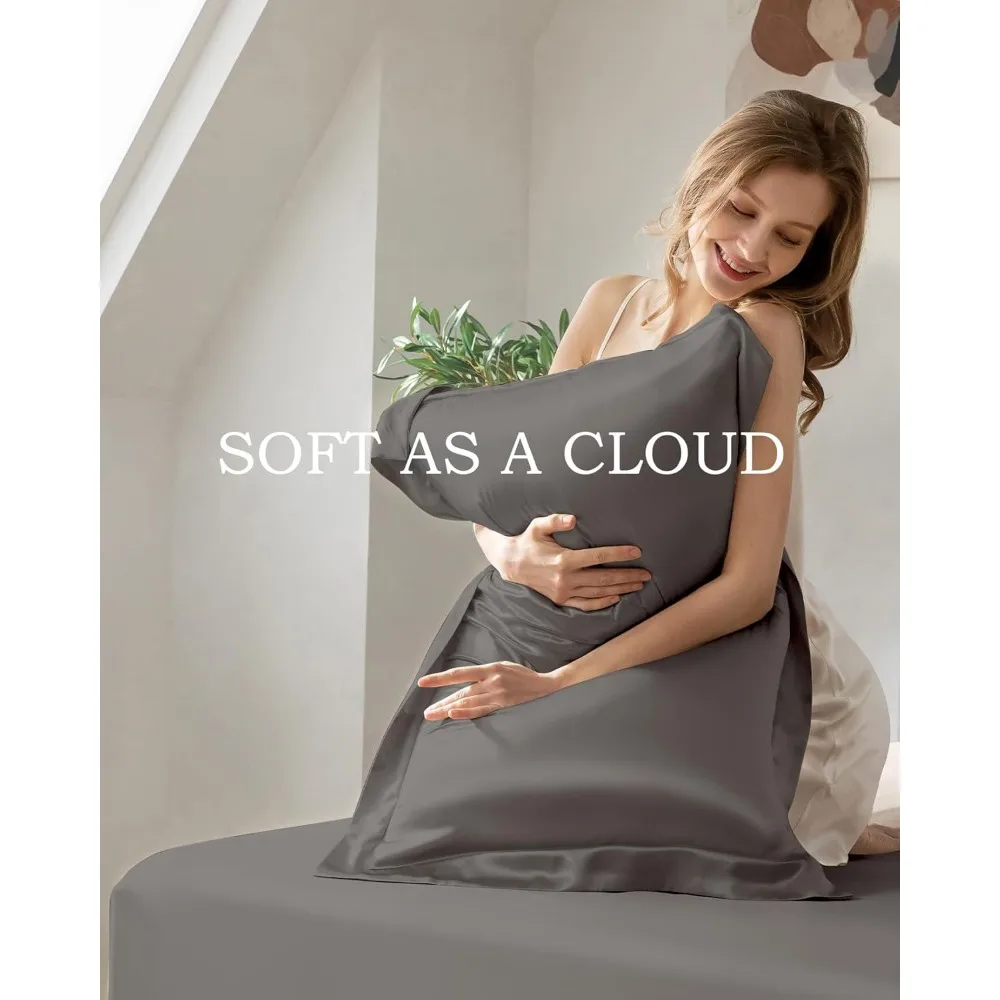
Discover why choose Mulberry silk sheets for a deeper understanding of silk’s unique benefits beyond measurements.
Quality Indicators Beyond the Numbers
While thread count and momme weight provide useful baselines for fabric quality, several other factors significantly impact the performance and feel of textiles:
Fiber Quality
The quality of the raw material greatly influences the final product:
– For cotton, long-staple varieties (Egyptian, Pima) produce softer, more durable fabrics than short-staple cotton, regardless of thread count
– For silk, Mulberry silk offers superior smoothness and durability compared to wild silk varieties, even at the same momme weight
Weave Type
Different weaving patterns create distinct fabric characteristics:
– Sateen weaves feel smoother and silkier but may be less durable
– Percale weaves feel crisp and cool but may feel less soft initially
– Twill weaves offer durability but with a distinctive diagonal pattern
– Charmeuse silk weaves provide the classic lustrous finish silk is known for
Finishing Processes
How fabrics are treated after weaving affects their performance:
– Mercerization improves cotton’s strength and luster
– Sand-washing silk creates a softer, more matte appearance
– Chemical treatments may increase wrinkle resistance but can reduce breathability
– Environmentally friendly processing preserves the natural benefits of the fibers
Certifications
Look for independent quality verifications:
– OEKO-TEX certification ensures textiles are free from harmful substances
– GOTS (Global Organic Textile Standard) verifies organic production methods
– Silk-specific certifications like “Grade A” or “6A” indicate quality mulberry silk
Our luxury silk bedding sets combine optimal momme weight with superior fiber quality and craftsmanship.
How Momme Weight Affects Silk’s Luxury Properties
Full-size Silk Sheets, King Size Silk Sheets, Queen Size Silk Sheets, Twin Size Silk Sheets, Washable Silk Sheets
Price range: $95.95 through $178.37 Select options This product has multiple variants. The options may be chosen on the product page100% Silk Sheets, Green Silk Sheets, King Size Silk Bedding Set, Mulberry Silk Bedding Sets, Queen Size Silk Bedding Set
Price range: $1,246.21 through $1,615.22 Select options This product has multiple variants. The options may be chosen on the product pagePink Silk Sheets, Twin Size Silk Sheets
$171.80 Select options This product has multiple variants. The options may be chosen on the product pageFull-size Silk Sheets, Pink Silk Sheets
$136.31 Select options This product has multiple variants. The options may be chosen on the product pageGrey Silk Sheets, Silk Sheet and Pillowcase Set
Price range: $88.20 through $146.64 Select options This product has multiple variants. The options may be chosen on the product pageBamboo Silk Sheets, Cooling Silk Sheets
Price range: $130.76 through $177.80 Select options This product has multiple variants. The options may be chosen on the product page
The momme weight of silk directly influences many of its most desirable properties:
Durability and Longevity
- Higher momme silks (19-25) resist wear and tear during regular use
- Denser fabric stands up better to washing and handling
- More silk protein per square inch means better structural integrity
- Higher momme silk typically maintains its appearance longer
Feel and Drape
- Mid-range momme weights (16-22) offer the most pleasant balance of body and flow
- Lower momme silks feel lightweight but may lack substance
- Higher momme silks feel more substantial against the skin
- The weight affects how the fabric moves and conforms to shapes
Temperature Regulation
- All silk naturally regulates temperature through moisture management
- Higher momme weights provide slightly better insulation in cold conditions
- Mid-range momme weights (19-22) offer optimal year-round temperature balance
- The protein structure of silk allows it to adapt to body temperature regardless of weight
Hypoallergenic Properties
- Silk’s natural resistance to dust mites, mold, and mildew exists across momme weights
- Higher density silk provides a more effective barrier against potential allergens
- The tight weave of higher momme silk may better protect against skin irritants
- Breathability is maintained even in denser silk fabrics
Visual Appearance
- Higher momme silk typically displays more lustrous sheen
- Greater opacity comes with increased momme weight
- The drape and flow of the fabric change with different weights
- Color richness and depth often appear more pronounced in higher momme silks
Our 100% silk sheets highlight these luxury properties with carefully selected momme weights for optimal performance.
Consumer Guide: Choosing Quality Fabrics
When shopping for quality fabrics, keep these practical tips in mind:
For Silk Products:
- For bedding, prioritize silk in the 19-25 momme range for the best balance of luxury and durability
- Look for “100% Mulberry silk” rather than just “silk” or “silk blend”
- Check for color consistency and evenness in the fabric
- Remember that extremely lightweight silk (under 16 momme) may not stand up to regular use as bedding
- Be skeptical of unusually low prices for supposedly high-momme silk products
For Cotton and Other Fabrics:
- Focus on fiber quality first (long-staple cotton varieties), then consider thread count
- Be wary of thread counts above 600, as these are often misleadingly inflated
- Consider the weave type based on your preferences (percale for crisp, sateen for silky)
- Look for certification labels that verify quality and safety
- Feel the fabric when possible—softness and drape often tell more than numbers
Warning Signs of Quality Misrepresentation:
- Extremely high thread counts (800+) at suspiciously low prices
- Use of terms like “silk count” or “silk thread count” instead of momme weight
- Vague descriptions of materials or country of origin
- Missing information about momme weight for silk products
- Unclear fiber content percentages in blended fabrics
Price Considerations:
- Quality fabrics are an investment—extremely low prices usually indicate lower quality
- The price difference between 300 and 1000 thread count often doesn’t reflect actual quality differences
- For silk, higher momme weights justifiably cost more due to the increased amount of raw material
Finding the best type of silk for bedding involves understanding these quality indicators and how they affect performance.
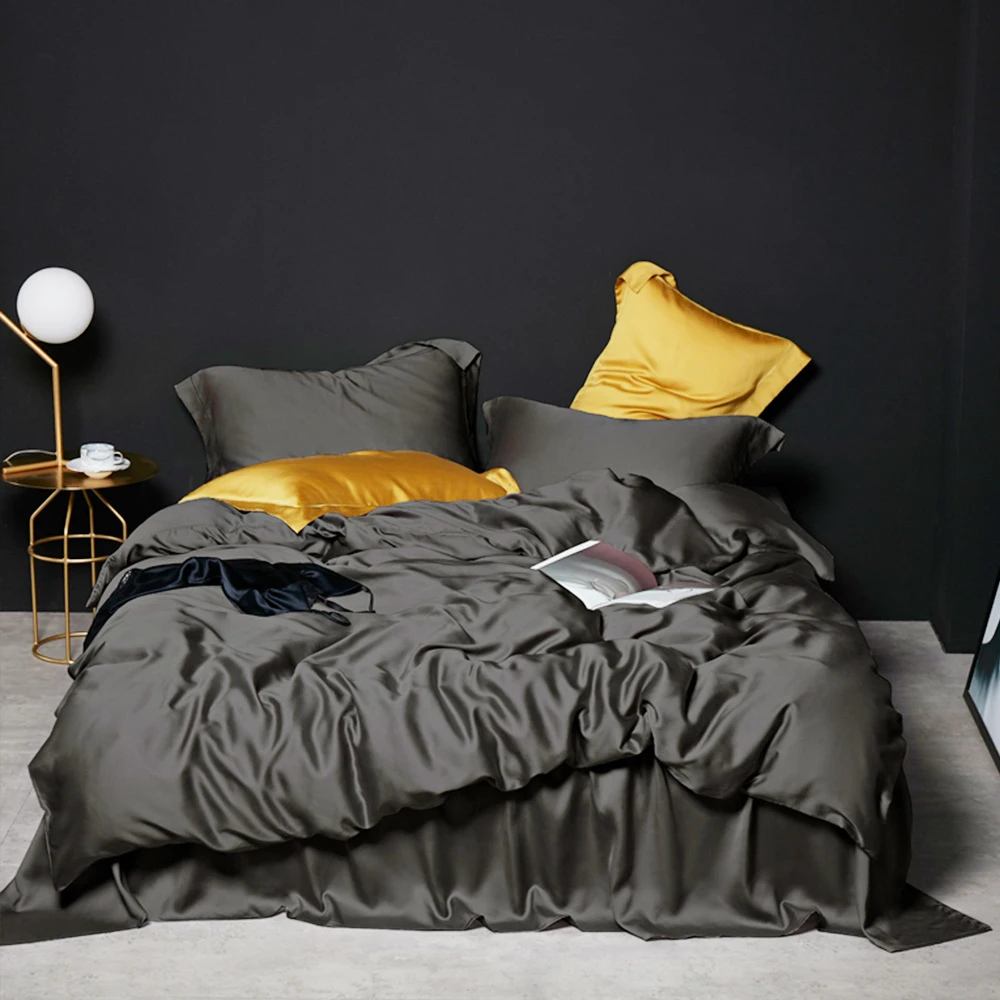
Frequently Asked Questions
Is higher momme weight always better for silk?
Not necessarily. While higher momme weights (19-30) indicate more durable silk with greater opacity, the ideal weight depends on the product’s purpose. Bedding benefits from 19-25 momme for durability, while clothing often works best with 12-16 momme for proper drape and movement. Extremely high momme silk (above 28) may feel too heavy for comfortable bedding.
Can silk have a thread count at all?
While silk technically has threads that could be counted, the industry standard is to use momme weight instead because silk threads are extremely fine (about 1/5 the diameter of human hair). Any product marketed with “silk thread count” is likely using misleading terminology. Always look for momme weight when evaluating silk quality.
What is the ideal momme weight for silk pillowcases?
For silk pillowcases, 19-22 momme provides an excellent balance of durability and comfort. This range offers enough substance to withstand regular use and washing while maintaining silk’s characteristic smoothness and beneficial properties for skin and hair care.
How does momme weight affect silk’s price?
Higher momme weight silk costs more to produce because it contains more raw silk material per square yard. For example, 25 momme silk has about 30% more silk than 19 momme silk, which naturally increases production costs. This price difference reflects a real difference in material content rather than just perceived value.
Is there a conversion between thread count and momme?
No direct conversion exists between thread count and momme weight because they measure fundamentally different properties. Thread count measures the number of threads per square inch, while momme measures weight. They are separate systems designed for different types of fabrics and cannot be meaningfully converted.
How do I care for different weight silks?
All silk should be washed gently in cool water with mild detergent, but care requirements vary slightly by momme weight:
– Lightweight silk (6-12 momme): Hand wash only, lay flat to dry
– Medium-weight silk (13-18 momme): Hand wash or delicate machine cycle, hang or lay flat to dry
– Heavier silk (19+ momme): Delicate machine cycle acceptable, can be hung to dry
Learning how to transform sleep quality with the complete guide to silk bedding can help you maximize the benefits of your silk investment.
The Truth About Marketing Claims
The textile market is filled with misleading claims that can confuse consumers. Here’s what to watch for:
Thread count inflation is one of the most common tactics. Some manufacturers count multi-ply threads individually, turning what should be a 300 thread count sheet into a “1200 thread count” product. In reality, extremely high thread counts often result in heavier, less breathable fabrics rather than better quality.
The term “silk thread count” is inherently misleading since the industry standard for silk is momme weight. If you see silk bedding advertised with thread count instead of momme weight, be skeptical about the seller’s knowledge and product authenticity.
Marketing language like “luxurious,” “hotel quality,” or “premium” has no standardized meaning. These terms can be applied to any product regardless of actual quality. Instead, look for specific, measurable indicators like momme weight for silk or verified fiber content for cotton.
To see beyond marketing claims:
- Request specific technical details about the fabric
- Look for transparency about the source and processing of materials
- Check for established quality certifications
- Read reviews that mention durability and performance over time rather than just initial impressions
By understanding the proper measurement systems and what they actually indicate about quality, you can make informed decisions about your textile purchases and invest in bedding that truly enhances your comfort and well-being.
At Sanctuary Soft, we believe in transparent quality measurements, which is why we clearly state the momme weight of all our silk products and provide honest information about our materials and manufacturing processes.

